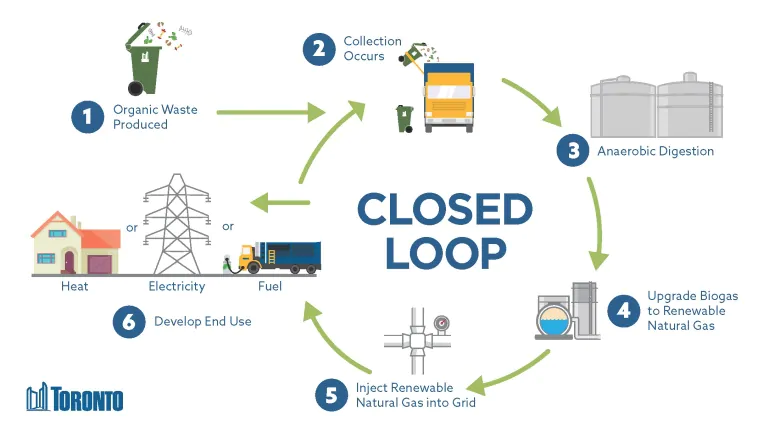How your food scraps are going to fuel Toronto's garbage trucks

Making sure food scraps end up in the compost and not the garbage just got more important as the City of Toronto is turning your organic waste into a gas that can be used to fuel trucks and even heat your home.
Pulling into the Dufferin Solid Waste Management Facility near Dufferin Street and Finch Avenue West, it doesn’t fit the stereotype of a garbage dump.
There’s no smell nor seagulls flying about. The property is divided into three enclosed areas, a spot each for garbage, compost and recycling.
On the organic waste side, there are anaerobic digesters — large cylindrical machines that are the centre of the operation. They take the organic material you toss into the green bin and break it down into either a solid or biogas.
“It’s exactly the same as the human body,” said Carlyle Khan, director of infrastructure and resources management at the City of Toronto.
“Ground up food goes into your stomach and then your intestines, the material starts to break down in the absence of oxygen,” he said.
“It results in the production of a solid or gas.”
10% of Toronto GHG emissions come from garbage
Since 2015, Toronto has been working to harness the biogas emitted from organic waste. After partnering with Enbridge to build a processing facility on the Dufferin site, biogas is now ready to fuel the majority of Toronto’s collection trucks. It’s one of the first cities in North America to do this.
The switch to biogas or renewable natural gas (RNG), will reduce the city’s carbon footprint, Khan says. The trucks that pick up your waste will drop it off at the plant and then go to a station where they will be fuelled with the biogas.
“It’s one of the most significant actions the city can take… because we’re not using resources to withdraw and clean fossil fuels, we’re using the waste that’s already produced,” said Khan.
RNG will also be injected into the natural gas grid, meaning that anyone connected to an Enbridge gas line will be able to use the gas.
Toronto’s fleet of 170 trucks won’t be running completely on RNG just yet. Starting in March 2020, when the official switchover happens, the gas will be mixed with natural compressed gas, which is methane stored at high pressures.
But Robert Dysiewicz, a business development manager for Enbridge Gas, says if the city fully switches to RNG, the vehicles “will be net neutral” in terms of carbon emissions.
As clean as electric cars
“They will be just as clean as any other electric vehicle or hydrogen vehicle being anticipated,” said Dysiewicz.

Once fully operational in the new year, according to the city, the Dufferin facility will process 55,000 tonnes of organic waste to create 3.2 million cubic metres of RNG. This means there will be 9,000 fewer tonnes of carbon dioxide ending up in the atmosphere.
The hope is to eventually start using RNG to fuel buildings and other public vehicles, says Dysiewicz. The only reason it’s not happening immediately is because the cost is still too high.

“It’s more expensive to produce renewable natural gas than to run fossil fuels like compressed natural gas … We’re hoping to improve on the technology and make it less expensive,” said Dysiewicz.
The public also has to do its part to improve the system by ensuring all organic waste goes into the green bin and doesn’t end up in the landfill where it takes 10 to 15 years to break down. When it finally does decompose, rather than being converted to RNG, that methane goes straight into the atmosphere as a greenhouse gas.
Currently, about 10 per cent of greenhouse gas emissions in Toronto are generated by garbage, primarily food waste.





